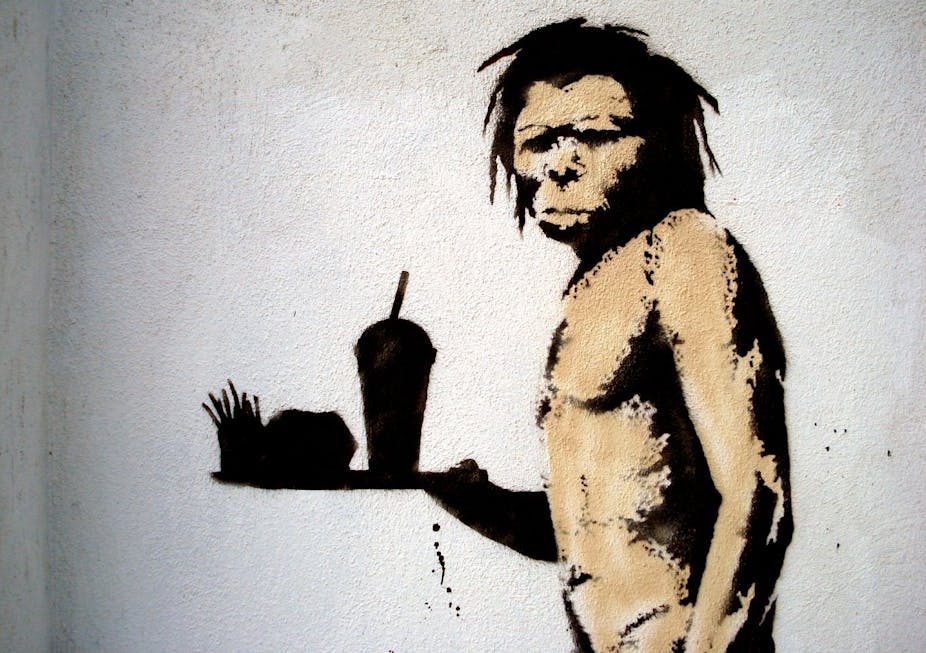Could we have found the first artist’s studio in human history? We may well have.
We all recognise the material signs of wealth. Fast cars, large yachts and sparkling bling all tell us who has more. Crowns, insignia, mayoral gowns are material signs of rank or status.
Archaeologists have long pondered when these public displays of social difference first occurred. Emerging evidence suggests the antiquity of public symbolism is surprisingly great.
Indeed, the symbolism of social difference seems to have been present from the earliest period of our species existence. The rise of Homo sapiens may even have been linked to the use of public symbols.
Recent work in southern Africa, published today in Science, is helping archaeologists clarify the early history of painting and its use in creating symbols.
Discoveries at Blombos Cave
The latest discovery comes from Blombos Cave, a large cavern located on the southern African coast, south-east of Cape Town.

Here a team, led by Christopher Henshilwood of the University of Bergen and Francesco d’Errico from the Université de Bordeaux, has found a 100,000 year old artist’s workshop.
Excavations of the deep sediments piled up in the cave have regularly yielded surprising finds. Archaeologists have previously recovered standardised bone tools, perhaps awls, and delicately-shaped tools of stone projectile points dated to 70,000 years ago.
Henshilwood and his colleagues suggest these tools show ancient artisans were able to plan and create a sophisticated technology.
Even more revealing is the presence of ochre, natural iron-rich rock that can be ground into powder and used as paint. Archaeologists have long suspected pieces of ochre with abraded facets in those early times might indicate paintings of some kind, on rocks, wooden artefacts or even human bodies.
Since 70,000-year-old ochre slabs have geometric engravings on their surface, it is clear early humans were artistic, but until now archaeologists could not be sure they were painters.
The world’s first studio
Now Blombos has yielded new materials that reveal the earliest artist’s workshop.
In a layer 100,000 years old, Henshilwood excavated two containers, which are probably artist’s palettes or mixing-bowls, and associated tools.
Each palette or bowl is a large abalone shell containing a residue of ochre, burnt bone and other materials that had been ground up and combined with some fluid into a vibrant red paste.

One of these containers also contained a small grinding stone and a number of bone fragments that had been used to stir the paste.
The other container was associated with fragments of ochre, in this case red ferruginous siltstone, that had been abraded to create the red powder and the grinding stones on which they had been rubbed.
Henshilwood speculates that for a short period about 100 millennia ago, the site was used primarily as a workshop for preparing and using the paint mixtures.
Why paint?
Henshilwood and his team think this early painting workshop may be an example of artistic developments associated with the emergence of Homo sapiens.
The genetic evidence, as well as ancient skeletons that have been found demonstrate humans evolved in Africa and migrated across the globe in the last 70-100,000 years.
Some recent genetic studies have even suggested our species originated in southern Africa, possibly not far from Blombos.
Did the earliest modern humans develop a knowledge of chemistry that helped them invent painting?
Or does this workshop reflect the emergence of art itself, a behaviour that was carried forth by humans in their global dispersion?
It turns out the evolution of art may have a very long history. Ochre has been found in far older African sites, dating back more than 300,000 years, as well as in Europe and the Middle East.

It’s been associated with hominids related, or ancestral, to us, such as Homo heidelbergensis and Homo neanderthalensis. If early hominids used ochre to colour themselves or their possessions then at least a basic form of painting had been present amongst hominids for several hundred millennia.
The artist’s workshop at Blombos 100,000 years ago is not the earliest use of ochre/paint but it represents a new intensity, a new scale, of artistry that may reflect a new role for painted public symbols.
This workshop was created near the start of the last Ice Age at a time when population size and resource availability changed.
In this context, signals of identity and differentiation perhaps assisted people to negotiate territory and trading relationships with neighbouring groups.
The Blombos discovery suggests the expression of social difference through painting was an important element in the development of modern culture.
We may well have found the beginning of a tradition that gave us Leonardo da Vinci, Rembrandt, Pablo Picasso, and, of course, Banksy.

